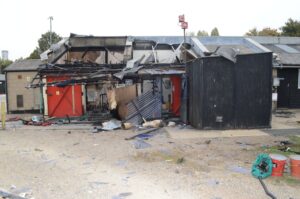McLaren fined as worker dies after falling at Formula One facility
Automotive group McLaren has been fined £650,000 after a father-of-five from Portsmouth fell to his death carrying out an inspection.
David Oldham’s widow, Patricia, says she has been “robbed” of her husband following the tragedy. The couple had been married for 14 years and lived in Hereford.
Fifty-five-year-old David worked for Zurich Management Services Limited. He was carrying out a structural inspection of McLaren’s Paddock Brand Centre, a hospitality unit used by its Formula One racing team, when he fell from one of the upper floors. He later died of his injuries.
The incident happened on 18 October 2016, while the structure was undergoing maintenance at one of McLaren’s warehouses on Vanwall Road, Maidenhead.

An investigation by the Health and Safety Executive (HSE) found McLaren had failed to properly assess the risks and to put measures in place to prevent workers falling from height at its Paddock Brand Centre.
Falls from height remain the biggest cause of fatal accidents involving workers. In the five-year period between 2017 and 2022, 174 workers in Great Britain – a quarter of those killed in accidents at work – tragically fell to their death. HSE guidance can be found at: Work at height – HSE
David’s wife Patricia Oldham said: “Davey was my husband for a short 14 years, although we had been together for 18 years. We had a happy time together and loved each other very much. He took care of me and I in turn took care of him.
“Our relationship was the kind that we could silently communicate to each other from the other side of the room. We used to work together and that is how we met and became good friends. Our wonderful, blended family consists of five grown up children, Chris, Dale, Nikki, Andy, and Simon. We have seven grandchildren and even a great-grandson! Dave loved his family and spoilt all of the grandchildren.

“A few months before he was killed at McLaren’s Paddock Brand Centre, we had taken all the grandchildren on holiday to Spain. We had an amazing time, especially poignant now given these circumstances.
“Dave was the kind of man who would help anyone if he could. He had such a big heart. His passion was golf, of which he enjoyed playing a round with his boys as well as myself and even to the extent of taking his grandchildren to the driving range. He used to like to keep fit and liked running, he did runs for charity.
“He used to make me laugh so much. Together we planned our retirement, where we would travel and see what new experiences we could explore together.
“I have been robbed of my husband, but poor Dave lost his life.”
Following a trial at Reading Crown Court, McLaren Services Limited, of Chertsey Road, Woking, Surrey, was found guilty of breaching Sections 2(1) and 3(1) of the Health and Safety at Work etc. Act 1974. The company was fined £650,000 and ordered to pay £110,132 in costs at Reading Crown Court on 31 March 2023.
HSE inspector Saffron Turnell said: “Patricia’s powerful words make clear the impact David’s loss has had on her life. This is a devastating tragedy and our thoughts remain with her and David’s family.
“Work at height is a high risk activity and falls can result in life changing injuries and death. It’s the number one reason why people like David didn’t get home from work. Those responsible to ensure his health and safety failed to do so.
“It is very important that those in control of the work identify the risk, plan to eliminate it if possible, or where it is not possible, take appropriate precautions to safeguard workers and others. Good management will also include regular monitoring that the controls in place are keeping people safe.”
Notes to Editors:
- The Health and Safety Executive (HSE) is Britain’s national regulator for workplace health and safety. We prevent work-related death, injury and ill health through regulatory actions that range from influencing behaviours across whole industry sectors through to targeted interventions on individual businesses. These activities are supported by globally recognised scientific expertise. hse.gov.uk
- More about the legislation referred to in this case can be found at: legislation.gov.uk/
- HSE news releases are available at: http://press.hse.gov.uk
- HSE guidance and information about work at height can be found at: Work at height – Occupational health and safety – HSE
- Falls from height deaths to workers: Year (number of deaths). Bold = biggest cause of work-related fatal accidents to workers during that year. 14/15 (42), 15/16 (37), 16/17 (27), 17/18 (35), 18/19 (43), 19/20 (31), 20/21 (36), 21/22 (29). Source –RIDKIND – RIDDOR reported fatal and non-fatal injuries in Great Britain by kind of accident and broad industry group (.xlsx)
- Following a trial at Reading Crown Court, Zurich Management Services Limited was found not guilty to breaching Section 2(1) of The Health and Safety at Work etc. Act 1974.



